After winning the first UEFA Nations League back in the 2018/19 season, Portugal got their 2020/21 UEFA Nations League campaign off to a positive start by romping to a 4-1 win over Croatia in their opening game of this season’s competition. They subsequently managed to earn a 2-0 victory in their second game of the 2020/21 instalment of the competition, against Sweden on Tuesday 8th September.
Thanks to their positive start, Portugal now sit atop the League A Group 3 table after playing two games, while Sweden sit in third place, on zero points.
In this tactical analysis piece, we will examine the tactics that Fernando Santos’ Portugal utilised to help them earn their recent 2-0 win over Janne Andersson’s Sweden. This tactical analysis piece will analyse both of these teams’ tactics in and out of possession from this past Tuesday’s game and we will discuss some of the key aspects to both teams’ tactics in this recent fixture.
Lineups and formations
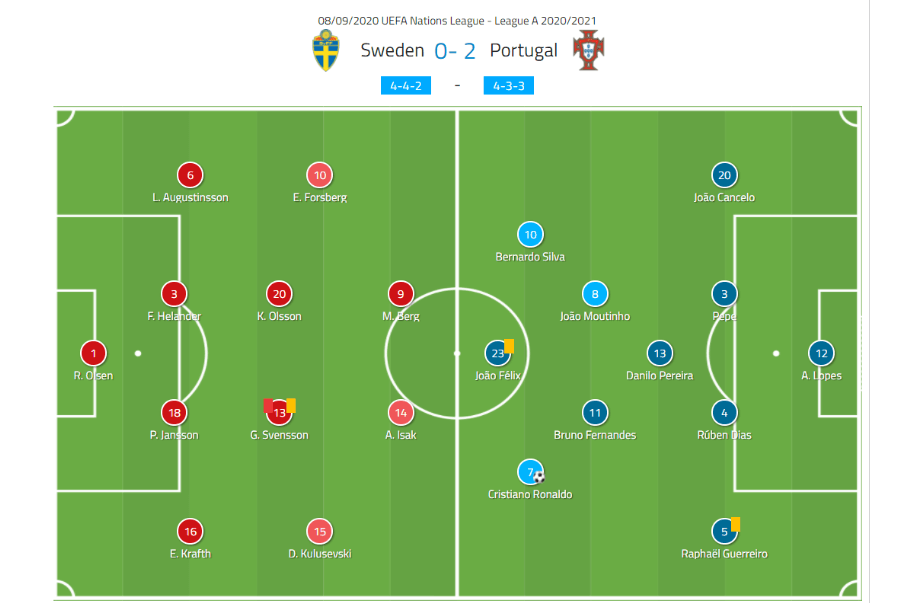
Firstly, we will look at the lineups and formations that both of these national teams used in this past Tuesday’s fixture.
Sweden started this game in a 4-4-2 shape. Their opponents had the lion’s share of the possession by the end of this match and as a result, the Swedes spent the majority of the fixture sitting in a rigid, compact 4-4-2 shape off the ball, the purpose of which was to try and restrict the amount of space that Portugal’s creative attacking players would be able to enjoy between the lines and in central areas.
AS Roma goalkeeper Robin Olsen started between the sticks for Andersson’s side, while a four-man backline consisting of Newcastle United right-back Emil Krafth, Rangers centre-back Filip Helander, Brentford centre-back Pontus Jansson, and Werder Bremen left-back Ludwig Augustinsson started in front of the Serie A keeper.
In midfield, Sweden played with Juventus’ Dejan Kulusevski on the right-wing, RB Leipzig’s Emil Forsberg on the left wing, and the central midfield pairing of Seattle Sounders’ Gustav Svensson and FC Krasnodar’s Kristoffer Olsson, while Olsson’s clubmate Marcus Berg joined Real Sociedad forward Alexander Isak up front.
As for Portugal, they lined up in a 4-3-3 shape for this fixture, which became a 4-1-4-1 quite often out of possession. However, as previously stated, Portugal dominated the ball in this game and spent the majority of their time utilising a very fluid, offensive 4-3-3 shape, while trying to break down Sweden’s solid defensive structure.
Olympique Lyonnais’ Anthony Lopes started in goal for Santos’ side and in front of him stood a back four comprised of Manchester City right-back João Cancelo, Borussia Dortmund left-back Raphaël Guerreiro, and a centre-back pairing of Benfica’s Rúben Dias and FC Porto’s Pepe.
Pepe’s clubmate Danilo Pereira anchored the midfield, while the EPL duo of Manchester United’s Bruno Fernandes and Wolverhampton Wanderers’ João Moutinho played in the two slightly more advanced central midfield positions.
Atlético Madrid’s João Félix, Manchester City’s Bernardo Silva, and Juventus’ Cristiano Ronaldo played in attack for Portugal in a fluid front three who frequently switched positions with one another and the central midfield duo of Fernandes and Moutinho who, in turn, would advance into Portugal’s forward line at times in this game.
Sweden in possession
Sweden ended this game with just 32% of the possession and as a result, their tactics without the ball will naturally make up a greater portion of this tactical analysis piece than their tactics on the ball will.
However, we will kick off the analysis portion of this piece by examining the tactics that Andersson’s side did utilise when in possession of the ball in this past Tuesday’s game.
A lot of the time, Sweden were quite happy to play with a more direct style right from the goal-kick. This was partly due to the fact that Portugal’s defensive tactics did make it difficult for the Swedes to play the ball out short from the back, as we will soon touch on.
However, when possible, Sweden did try to play it short from goal-kicks and build through the centre-backs in this game. From the central defenders onwards, however, they were then usually quite happy to pick out long-balls and try to cause problems for the Portuguese defenders by utilising the height of Isak (190cm or 6’3”) to their advantage. These long-balls did cause some problems for the Portuguese defence at times, however, they weren’t effective enough to really break down the defence of the reigning UEFA Nations League champions.
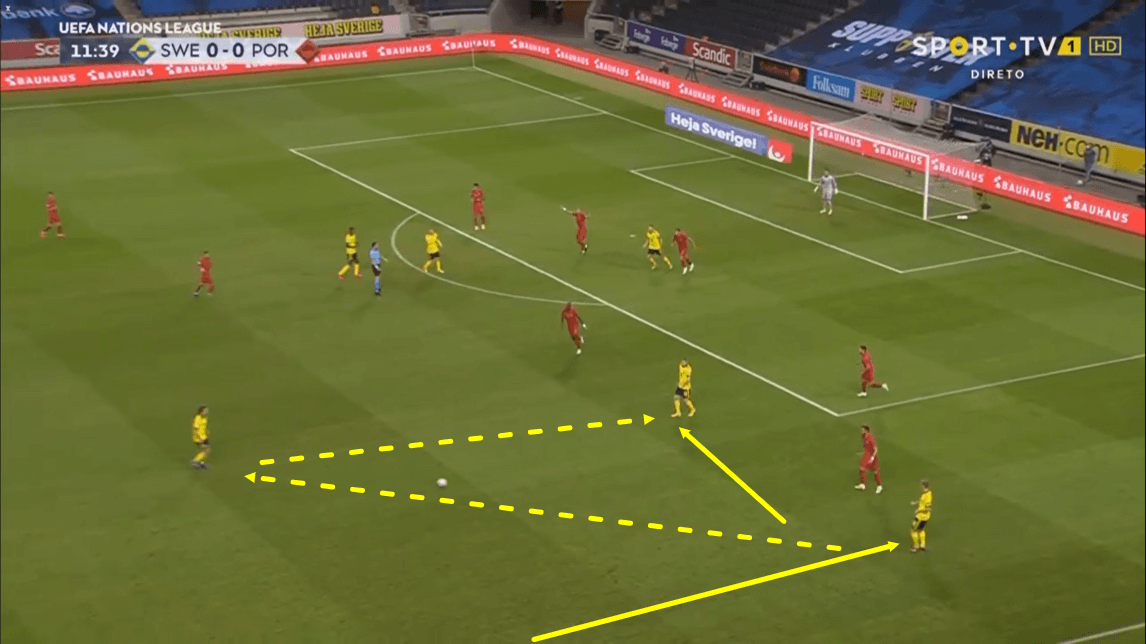
When in possession of the ball in the final third, Sweden created the type of scenario we can see in this image above on a number of occasions during this match.
On both the right and left-hand side of the pitch, their full-back tended to overlap the winger, allowing that wide man to drift inside into the half-space and as the near-sided central midfielder moved over in support, this created a simple triangle between the full-back, the winger and the central midfielder in which they played some quick, short passes in an attempt to break through the Portuguese defence.
Quick one/two-touch passing plays were a common theme to Sweden’s game in possession of the ball in advanced areas of the pitch in this game and the creation of these wide triangles and the winger’s movement into the half-space helped them to pull off those quick, short passing plays.
However, despite their efforts on the ball, they were unable to create enough problems for Portugal’s defence to actually get a goal in this one.
Portugal out of possession
Portugal didn’t generally challenge for the ball particularly aggressively in advanced areas of the pitch in this game. However, while they weren’t the most aggressive side in the world in terms of their pressing, they did mark opposition players tight in advanced areas of the pitch, which resulted in those potential passing options being taken out of the game for Sweden during the build-up.
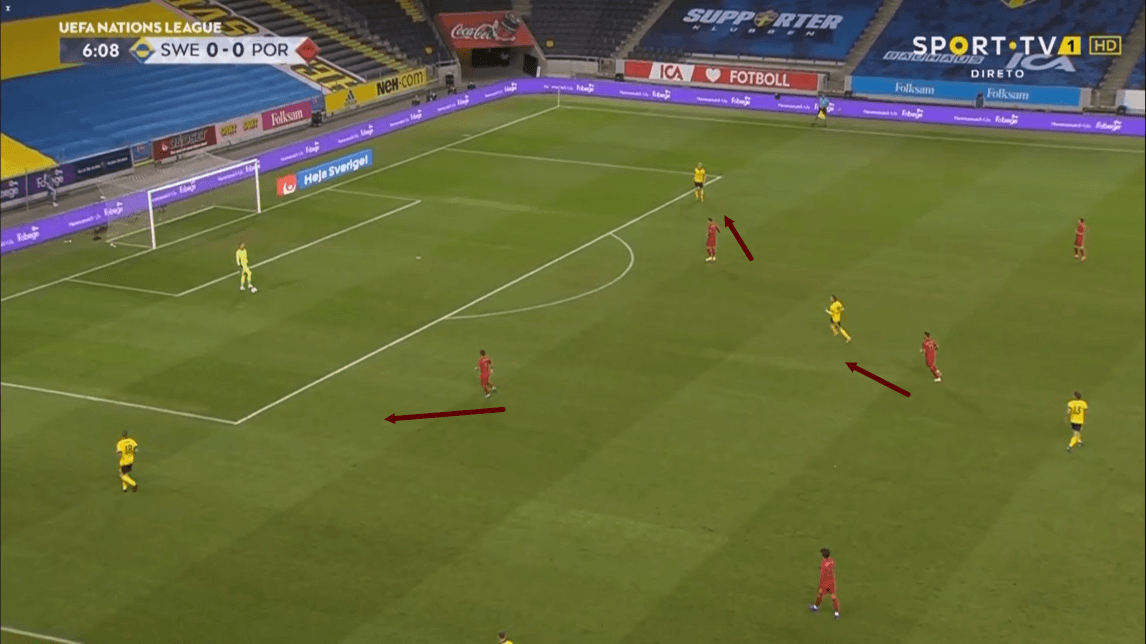
These defensive tactics from Portugal made it difficult for Sweden to play out from the back and, in particular, from goal-kicks, as we touched on previously in this tactical analysis piece. We can see an example of Portugal’s man-marking system in action in the image above.
Here, we can see the Portuguese attacker occupying the centre forward position at this moment sticking tight to a Swedish midfielder who is dropping in between the two centre-backs in an attempt to provide an additional passing option to Olsen, while the two Portuguese attackers occupying the wide positions maintain access to the two Swedish centre-backs who can be seen splitting wide here.
These players’ positioning forces Sweden to go long from the goal-kick, rather than play the ball out short.
Portugal defended in this way at all times when the ball was in the opposition’s half of the pitch and this man-marking system, combined with a very narrow defensive shape, made it difficult for Sweden to play out short from the back and progress the ball through the centre of the pitch.
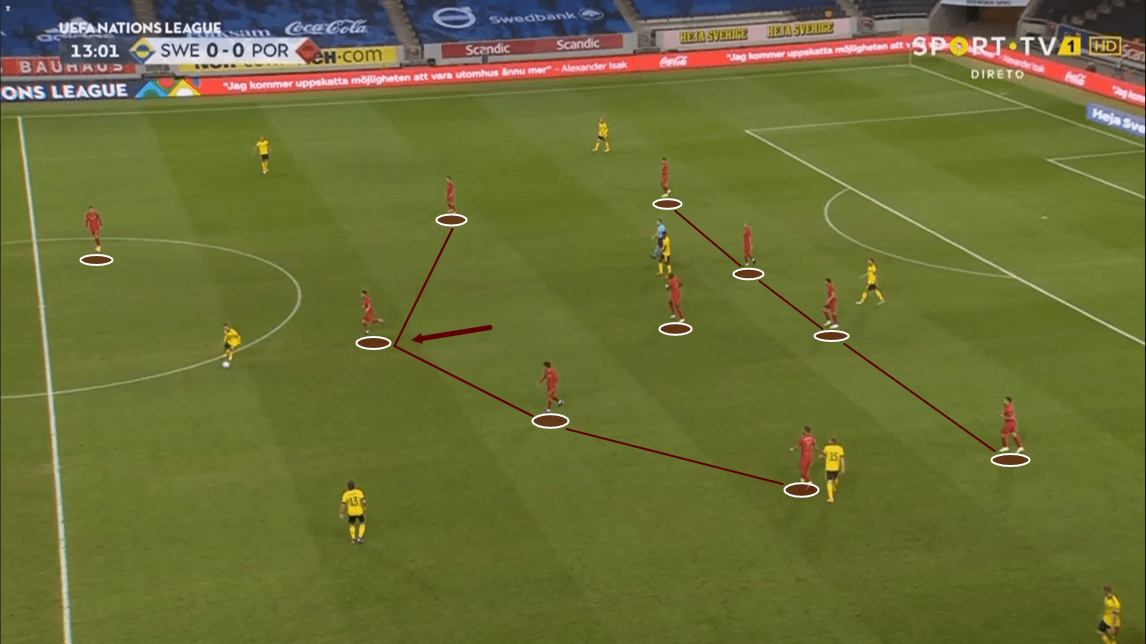
This next image above shows us how Portugal shaped up when Sweden were in possession of the ball in the Portuguese half of the pitch. As we can see, Santos’ side dropped into a more rigid 4-1-4-1 shape during this phase of play, however, as we can also see in this image, the midfielders were still given license to press more aggressively when the ball was played to a Swedish player in close proximity to them.
Here, we can see Portugal’s right central midfielder departing his base position to close down the Swedish player in possession as he receives the ball. This more aggressive element of Portugal’s defensive tactics was present even when they were defending in deeper areas of the pitch and operating in a more rigid defensive shape, as a collective.
Pereira’s positioning at the base of Portugal’s midfield bridged the gap between the midfield and the defence and prevented large holes from opening up in the Portuguese defensive shape when one of the two more advanced central midfielders pressed like this.
Sweden out of possession
The Swedes set up in a rigid, compact 4-4-2 defensive shape throughout this contest. Though their forwards did, at times, apply pressure to Portugal’s defenders, Andersson’s side didn’t typically press Portugal very aggressively while they build up their attacks.
They were happy to defend inside their own half and play a patient and disciplined game without the ball. When defending inside their own half, Sweden typically set up in a very vertically and horizontally compact mid-block, which was designed to restrict the amount of space that Portugal’s offensive players had to operate in, inside of the Swedish half.
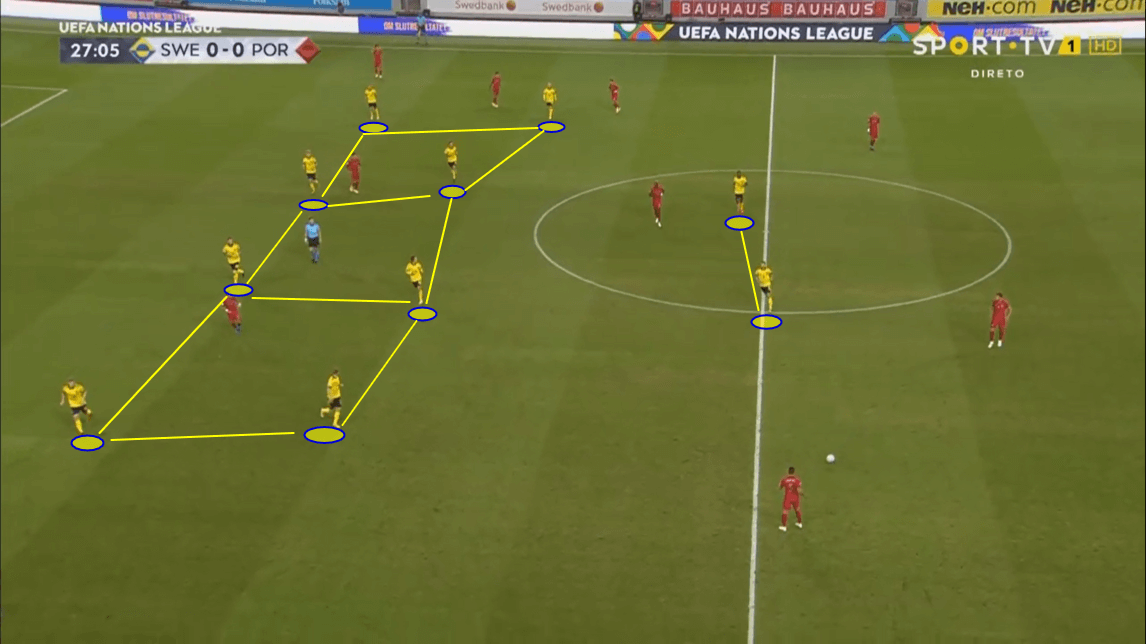
The image above provides us with an example of how Sweden shaped up without the ball in Tuesday’s game. As we can see here, Portugal are in possession of the ball, just building into the Swedish half of the pitch.
Meanwhile, we can clearly see Sweden operating in their rigid and compact 4-4-2 structure. Due to its horizontally compact nature, this defensive shape helped Sweden to congest central areas of the pitch and prevent Portugal from playing through them, while their vertical compactness limited the space that Portugal’s attackers were able to move into between the lines and this then limited Portugal’s options when trying to build from the middle third into the final third of the pitch.
Furthermore, Sweden’s two centre forwards played an important role in the defensive side of their game. As the image above shows us, one centre forward essentially blocks off the passing lane from Guerreiro to Pereira, while the other centre forward sticks quite tight to the holding midfielder and this takes the possibility of playing through him during this stage of the build-up out of the game for Portugal.
Additionally, the Swedish centre forwards had the role of applying pressure to Portugal’s more advanced central midfielders when they dropped deep to get onto the ball during the build-up and they were effective in this role, as we will touch on later when discussing Portugal’s tactics in possession of the ball.
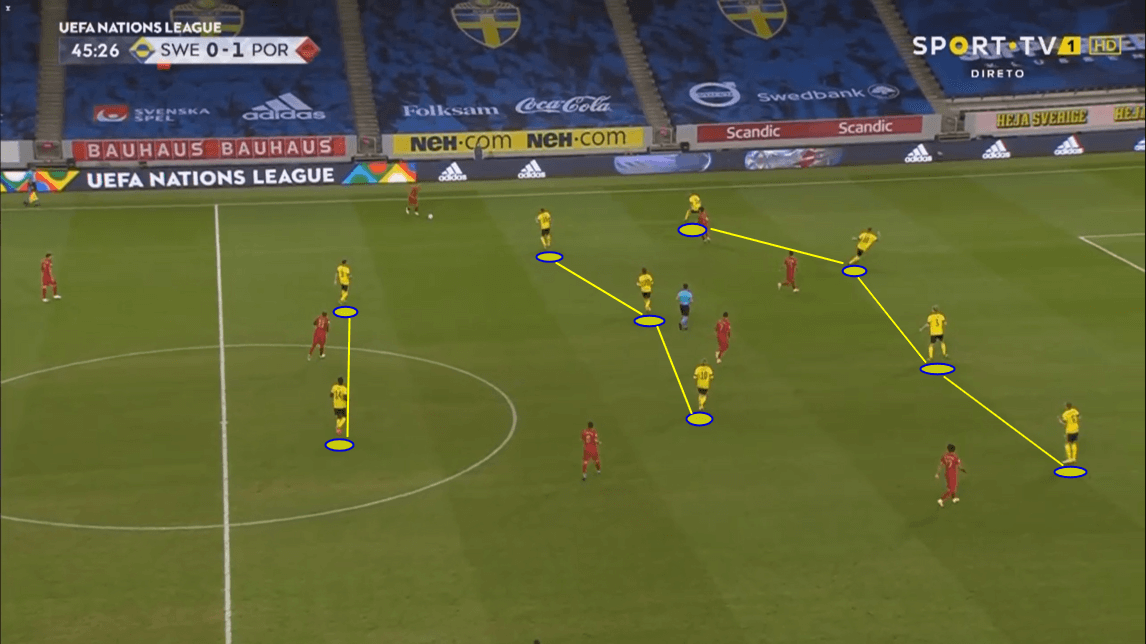
Central midfielder Svensson received a red card just before half-time – sending Sweden down to 10 men. As the image above shows us, Andersson’s side opted to line up in a 4-3-2 shape for the second half as a result of this sending off.
This allowed them to keep both of their two centre forwards on the pitch and considering how important their roles were in the defensive side of the game, particularly during Portugal’s build-up, it isn’t too surprising that Andersson opted to ensure that their roles were not affected by the sending off.
Instead, Sweden ended up sacrificing some width due to the sending off and switched to a three-man midfield. However, Portugal did end up exposing this shape and its weaknesses in terms of width on some occasions and we will touch on how they managed to do that later on in this tactical analysis piece when discussing Portugal’s tactics in possession.
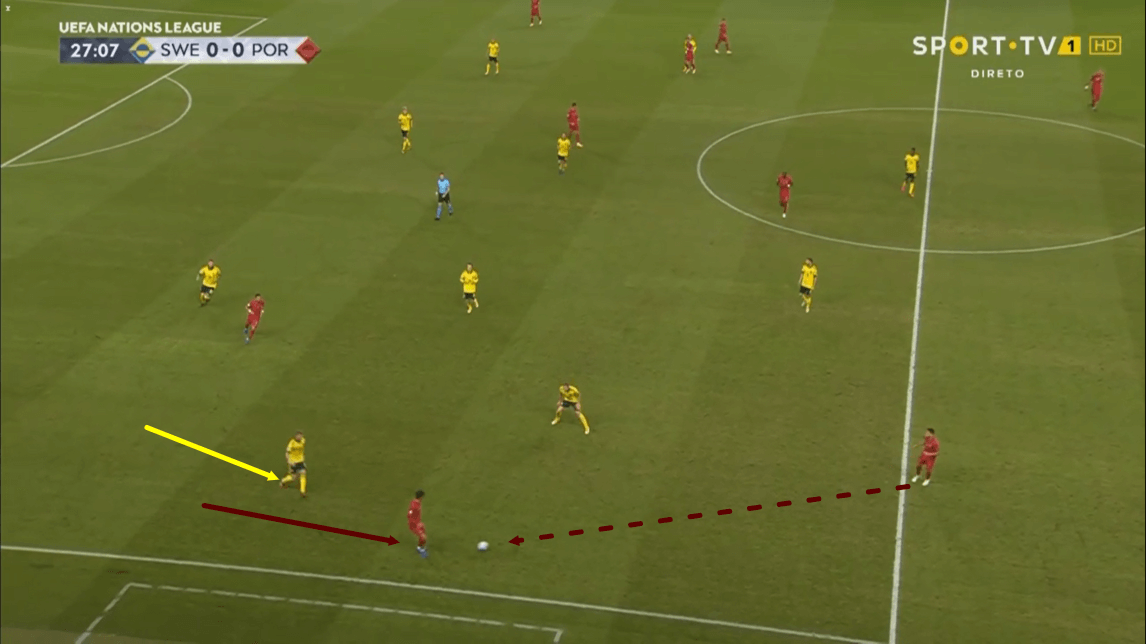
One notable element to Sweden’s defensive tactics was how their players got tight to particular opposition players when the ball was played into the Swedish half of the pitch.
While Sweden’s players typically occupied an exact position within the team’s overall rigid defensive shape, when the ball was played to a nearby player, such as the Portuguese left-winger in the image above, a nearby Swedish player, such as the right-back here, could often be seen stepping out and applying pressure to this opposition player as they received the ball, in an attempt to prevent them from enjoying time and space to create, or to even turn and face the Swedish goal, in some cases, one being in this particular scenario.
Portugal’s central midfielders and winders were constantly closed down like this during the game and this made it more difficult for them to influence play while their team was attempting to build into the final third.
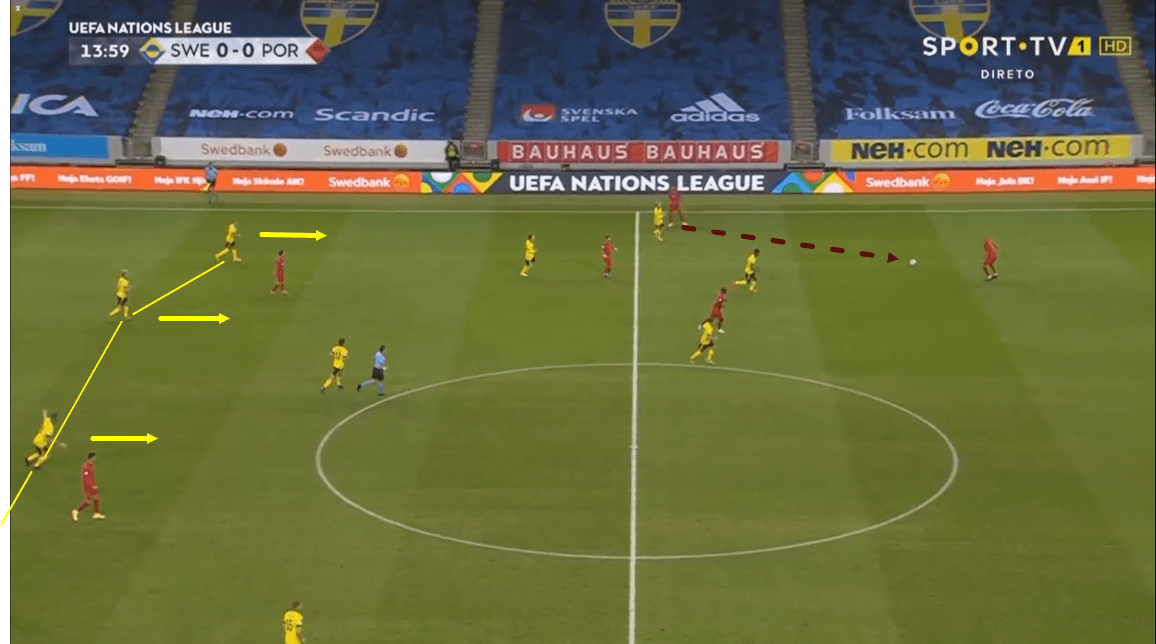
Another element of Sweden’s defensive tactics that was clear in this past Tuesday’s fixture was how their backline organised themselves and frequently advanced the height of their line in order to compress the pitch and limit the amount of space that Portugal actually had to play in when in possession of the ball.
While defending in their mid-block, Sweden were patient and disciplined, typically biding their time as a collective unit and waiting for Portugal to make an unforced error which would allow the Swedes to then spring a counterattack.
However, when Portugal played a backwards pass, such as the one we can see them playing in this image above, their backline would sometimes take the opportunity to advance their position slightly – thus, restricting the field of play even more for Portugal, although this did also create a greater amount of space for Portugal’s attackers to target in behind the Swedish defensive line. We can see Jansson marshalling the defence and leading his defensive partners in advancing their position slightly in this image.
It’s clear that Sweden prioritised restricting the amount of space that Portugal’s creators had to play in, inside the Swedish half of the pitch, as is evident by their compact defensive shape, the players’ willingness to advance from their position to close down nearby ball receivers, and the backline’s tendency to advance a few yards up the pitch when they had the chance.
Portugal in possession
Portugal’s offensive tactics saw their front five – in their three attackers and two advanced central midfielders – interchange positions quite frequently. Additionally, while they lined up in a base 4-3-3 shape, their offensive formation generally resembled something closer to a 3-2-5 shape, in actuality.
This was because one of either Fernandes or Moutinho would usually depart from midfield and join the attack, while one of either Cancelo or Guerreiro also tended to get forward and provide some offensive width.
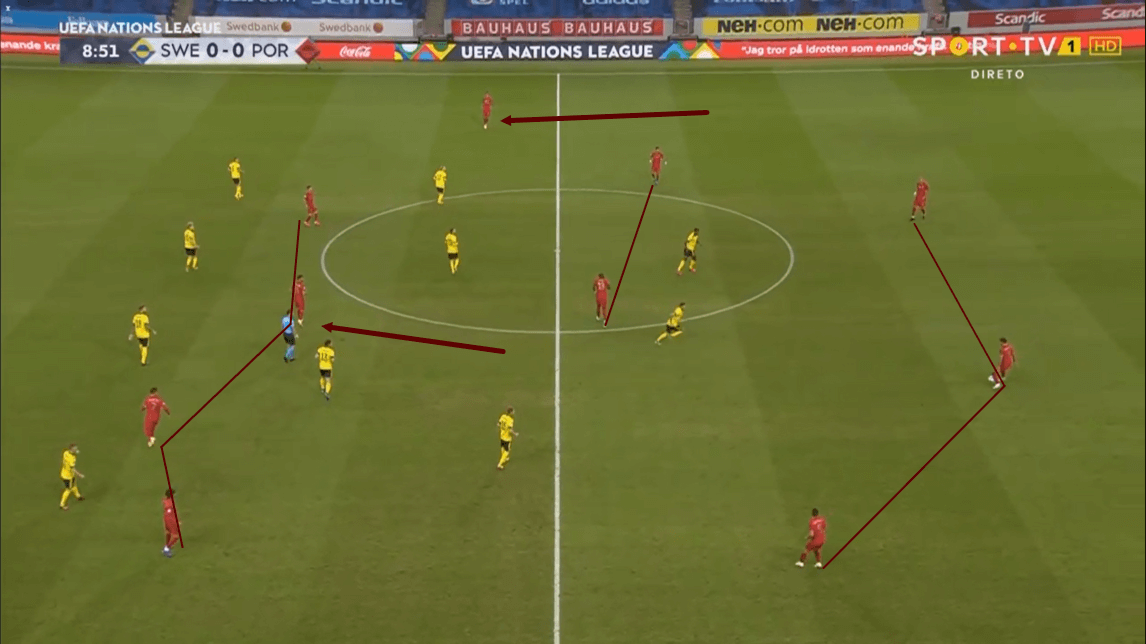
We can see an example of Portugal’s typical offensive shape from this past Tuesday’s game in the image above. Here, we can see that Cancelo and Fernandes have joined the attack, essentially forming a five-man front line. This leaves Portugal with two central midfielders and three defenders during the build-up.
As we can see, Portugal’s creation of a five-man front line creates an overload versus the opposition’s four-man backline. This was dangerous for Sweden, as Portugal’s four attackers here occupy one of Sweden’s four defenders each and this then pins those players into a narrow position and as Cancelo advances into the attack on the overlap, he enjoys plenty of space out wide. If the opposition full-back moves out to him, then he frees up space for another player in the centre and if he doesn’t move out, then Cancelo can enjoy that space to create.
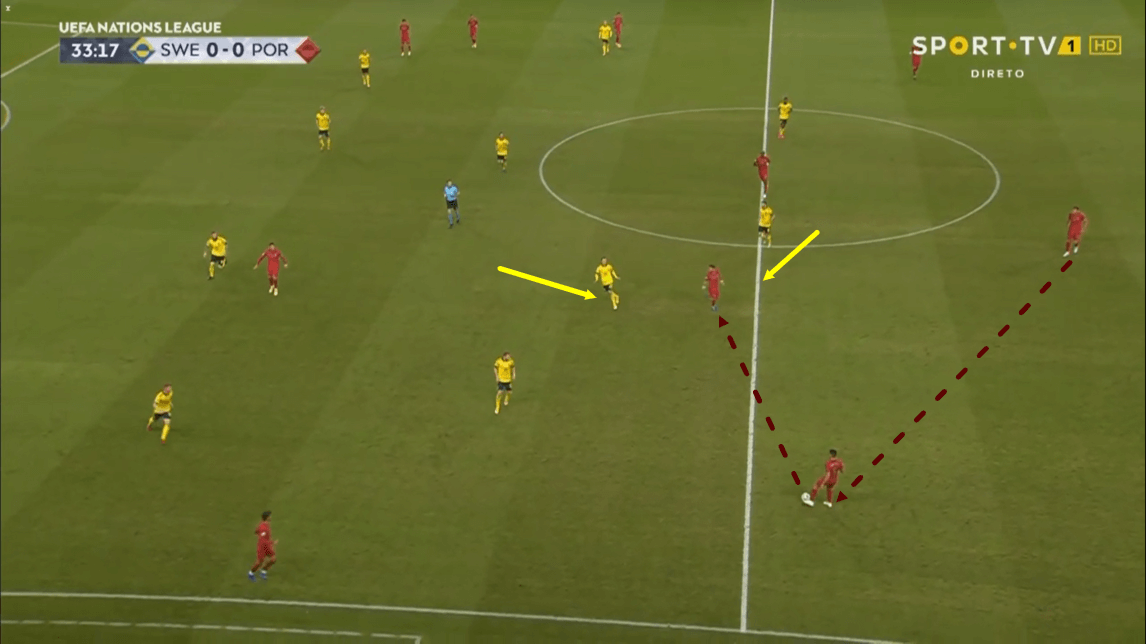
During the build-up, as we can see in this next image above, Portugal often played it short from the centre-backs out to the full-backs, who would then look for either a direct pass into the final third or a pass into the midfield, likely to one of the two advanced central midfielders who often dropped deeper during the build-up phase.
We can see that Fernandes is being followed by a Swedish midfielder, as he drops from the centre of the park out to the full-back, which provides us with another example of Swedish players getting particularly and noticeably tight to Portuguese ball receivers.
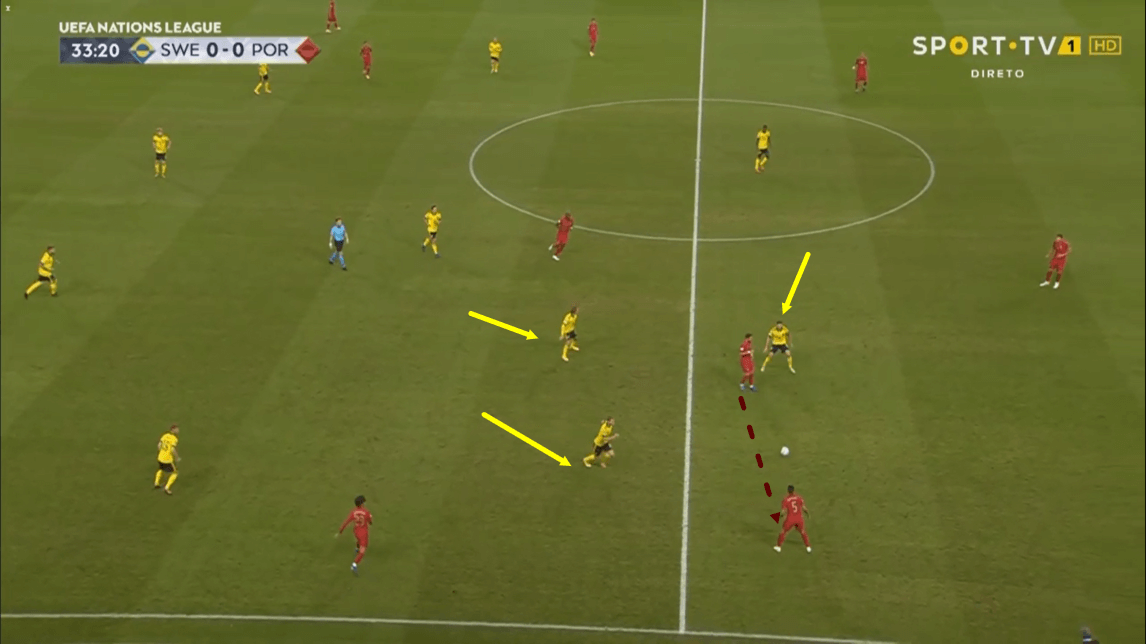
This next image shows us that as this passage of play moves on, the nearest Swedish centre forward also quickly dropped deep and joined the midfielder in applying pressure to the Portugal player.
This pressure results in Fernandes playing the ball straight back out to the full-back who he had originally received it from on this occasion, however, on plenty of other occasions in this game, these tactics in the build-up were successful for Portugal and this pass from the full-back into the dropping midfielder appeared to be a key element of their offensive tactics.
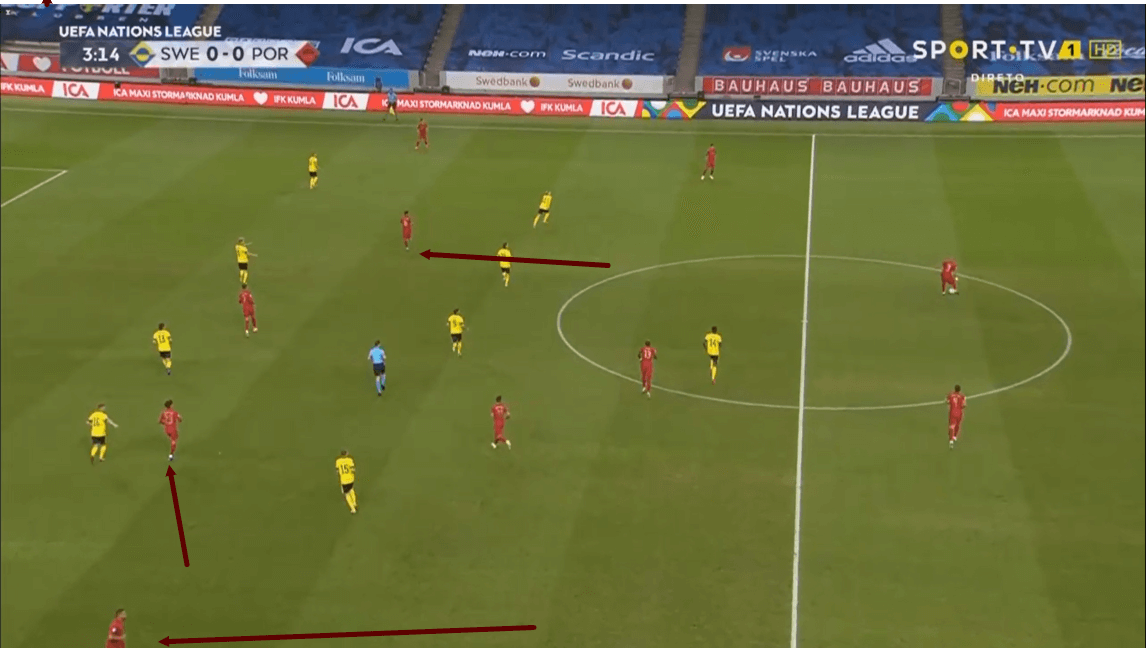
Portugal’s players were constantly moving around and switching positions and exchanging roles in the final third which may have made them more difficult to keep track of and prevent from getting onto the ball.
In this image above, we can see that Guerreiro has picked up an advanced position high on the left wing on this occasion, which results in the Portuguese left-winger then shifting inside, which, on this occasion, creates more space for Guerreiro on the overlap.
Additionally, here we can see that Moutinho is in the right half-space in a dangerous position, should he receive the ball here, while Fernandes was occupying the central midfield position here.
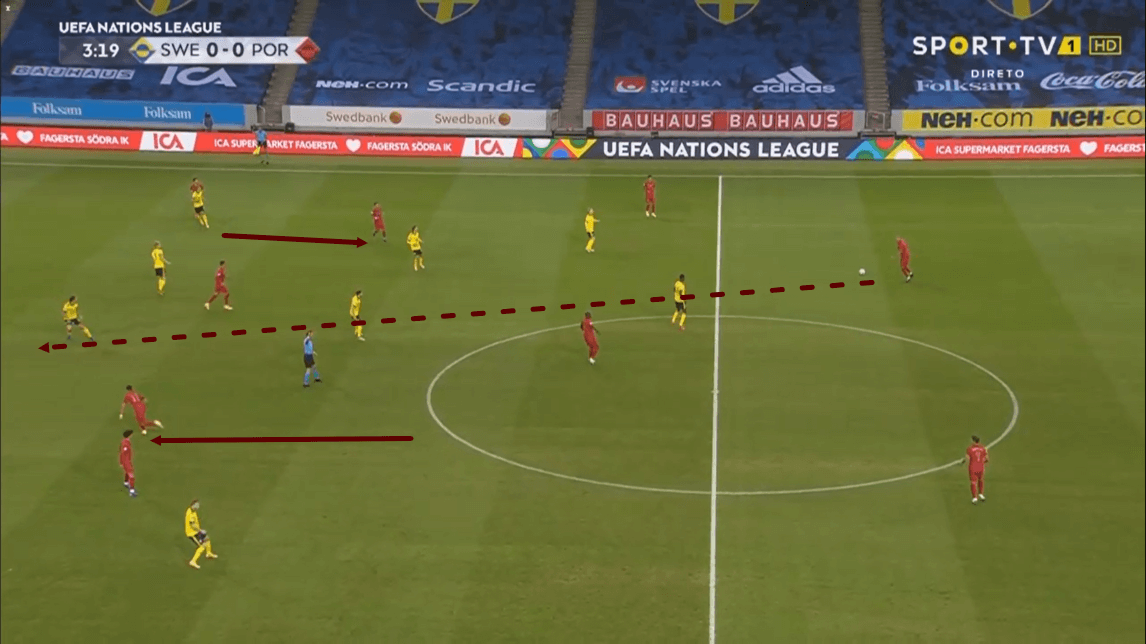
However, as play moves on, we can see that as Moutinho makes his way back from the attacking line to the midfield, his central midfield partner Fernandes begins a darting run in behind the Swedish defensive line.
This provides us with an example of the understanding and the partnership that exists between Fernandes and Moutinho and indeed, other players within the Black Cats’ squad. This type of constant movement made Portugal’s players difficult to track and it was an effective tactic at helping them to break into the final third and carve out chances against a well-organised Swedish defence.
With Sweden typically defending in a narrow, compact shape, Portugal’s quality on the wings was important in this past Tuesday’s fixture as this is where they were more likely to enjoy time on the ball.
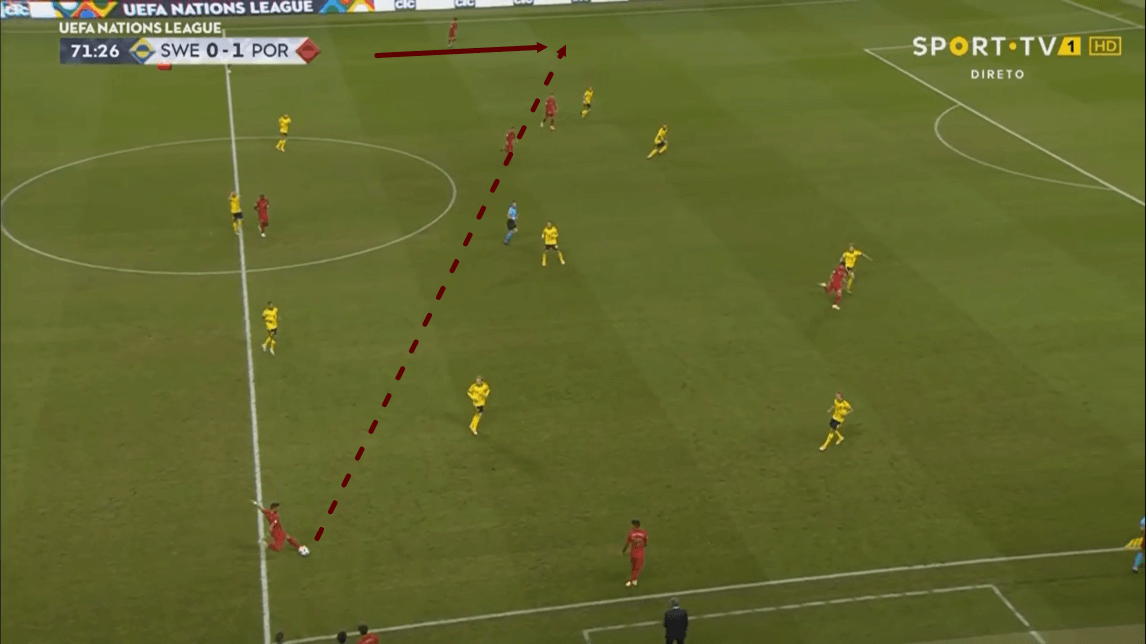
Additionally, Sweden’s narrow, compact shape resulted in the central areas of the pitch being difficult to play through, however, Santos’ side got around that problem through the use of crossfield balls, like the one we see being played in the image above.
Portugal utilised these kinds of passes throughout this past Tuesday’s game as their quick switches of play were designed to create gaps in the opposition’s defensive line. However, these crossfield balls were particularly effective after Sweden had gone down to 10 men and were playing with one less man in midfield.
The image above provides us with an example of one occasion in the second half, after Sweden had gone down to 10 men when this kind of crossfield pass was played. The ball is successful and as Guerreiro receives the pass, he attracts the attention of the opposition full-back and this, combined with some unselfish movement from another attacker, creates space for Ronaldo outside of the box, and he scores a goal to put this game to bed, as a result of this attack which stemmed from the crossfield ball.
Conclusion
To conclude this tactical analysis piece, both of these teams displayed some interesting tactics at certain points in this past Tuesday’s game, however, Santos’ Portugal ultimately had too much for Andersson’s Sweden outfit.
It’s clear that factors like Svensson’s sending-off played a huge role in how this fixture panned out, but it is also clear that Portugal’s fluid, offensive shape and the direct, risky passing elements to their game were key in helping them to create the goalscoring chances to take all three points here.




Comments